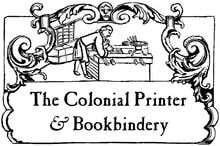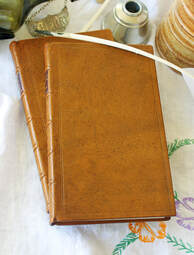
Historically Accurate Binding
This style of binding is as close to 18th century as most can find. The leather is either calf or sheep, vegetable tanned and then hand dyed by us. The text is sew on Irish linen cords that are hand rolled by us to make them the proper size for the period. Before the leather is applied to the boarded text, we hand sew 'headbands' on both the head and foot of the spine edge of the text.
The leather is then pasted to the book & boards using a natural organic paste used heavily in centuries past. Once dried, the leather undergoes several laborious processes to finish the leather. Albumin glazing and hot iron polishing create a smooth luster. The book is decorated in a period style with blind tooling and a 23k gold leaf titling label on the spine. Small books or books with thin spines may not have titleing.
This style of binding is as close to 18th century as most can find. The leather is either calf or sheep, vegetable tanned and then hand dyed by us. The text is sew on Irish linen cords that are hand rolled by us to make them the proper size for the period. Before the leather is applied to the boarded text, we hand sew 'headbands' on both the head and foot of the spine edge of the text.
The leather is then pasted to the book & boards using a natural organic paste used heavily in centuries past. Once dried, the leather undergoes several laborious processes to finish the leather. Albumin glazing and hot iron polishing create a smooth luster. The book is decorated in a period style with blind tooling and a 23k gold leaf titling label on the spine. Small books or books with thin spines may not have titleing.
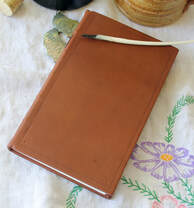
Full Leather Binding (Commercial Leather)
Full leather books have a single piece of leather that covers the entire book.
These bindings are made to be more affordable by using a commercially tanned leather, often mineral tanned, using either sheep or cow. Their are finish and color are created in the tannery also using chemical methods. Although we do our best to select leathers that reflect an 18th century 'look', they may not reflect that true color and feel.
Full leather books have a single piece of leather that covers the entire book.
These bindings are made to be more affordable by using a commercially tanned leather, often mineral tanned, using either sheep or cow. Their are finish and color are created in the tannery also using chemical methods. Although we do our best to select leathers that reflect an 18th century 'look', they may not reflect that true color and feel.
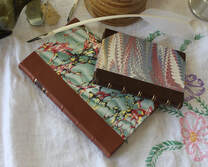
Half Binding
In this style of binding you find that leather only spine and four corners are covered in leather. The balance of the cover is wrapped in hand made marbled papers. Marbled in a variety of colors and patterns of the period.
In this style of binding you find that leather only spine and four corners are covered in leather. The balance of the cover is wrapped in hand made marbled papers. Marbled in a variety of colors and patterns of the period.
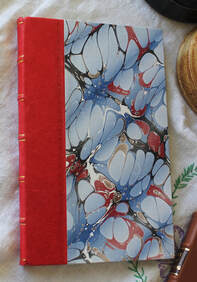
Quarter Binding
A book that has quarter binding is (and was) made to create a more economical binding style. By only covering the spine with leather leather means cheaper material costs. Plus creating the outside corners with paper is quicker than forming one with leather.
A book that has quarter binding is (and was) made to create a more economical binding style. By only covering the spine with leather leather means cheaper material costs. Plus creating the outside corners with paper is quicker than forming one with leather.
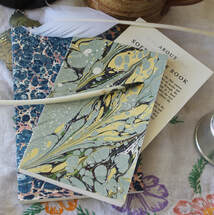
Soft Cover Books
There are multiple examples of complete books that were sewn and covered with paper, both marbled and colored. These books are sewn through the folds for easy opening and reading. Also standard for the 18th century is that these soft covers did not have titling in the front cover or spine. However, in today's times, our personal libraries are more extensive and many may want some form of titling. Each soft cover book comes with a sheet that explains this historical fact, but also offers a printed title and blank paper if you desire to hand write a title to look authentic.
There are multiple examples of complete books that were sewn and covered with paper, both marbled and colored. These books are sewn through the folds for easy opening and reading. Also standard for the 18th century is that these soft covers did not have titling in the front cover or spine. However, in today's times, our personal libraries are more extensive and many may want some form of titling. Each soft cover book comes with a sheet that explains this historical fact, but also offers a printed title and blank paper if you desire to hand write a title to look authentic.
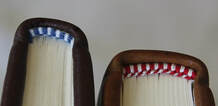
Headbands
Not all books in the 18th century had headbands. My replicas may not have headbands depending on location and time of the original's binding. On the left is a commercially woven headband applied for affordability. On the right is a hand sewn headband. These are more labor intensive and create a more costly book.
Not all books in the 18th century had headbands. My replicas may not have headbands depending on location and time of the original's binding. On the left is a commercially woven headband applied for affordability. On the right is a hand sewn headband. These are more labor intensive and create a more costly book.
Copyright 2023by The Colonial Printer & Bookbindery
Images and text are the property of C.P.&B. and may not be copied or used without explicit permission.
Proudly powered by Weebly
